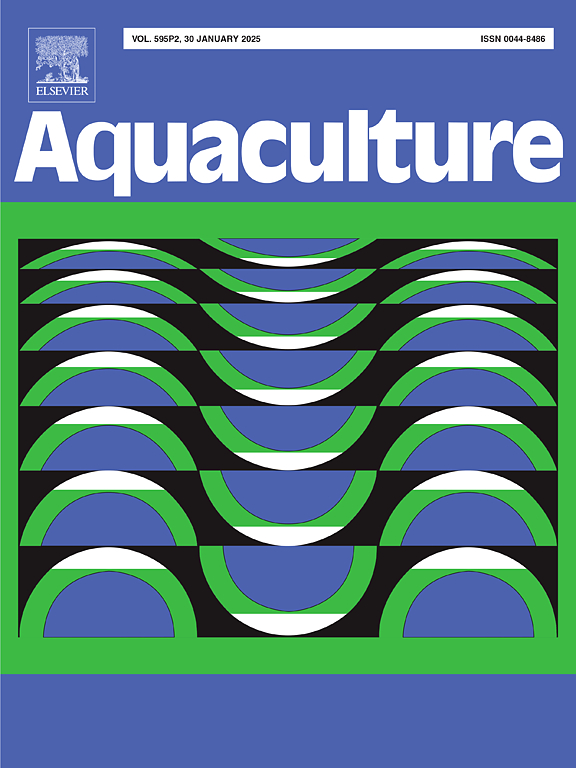In–situ aquaculture treatment: Co–addition of autotrophic and heterotrophic bacteria with biodegradable polymers (PHBV) to Penaeus vannamei culture systems
IF 3.9
1区 农林科学
Q1 FISHERIES
引用次数: 0
Abstract
As a novel trend, biodegradable polymers, specifically poly(3–hydroxybutyrate–co–3–hydroxyvalerate) (PHBV), are being utilized as carbon source and biofilm carrier in the in–situ aquaculture systems to remove nitrogen from wastewater. This study investigated the differential responses to various aquaculture systems with the addition of autotrophic bacteria and PHBV (PNB group), heterotrophic bacteria and PHBV (PBS group), autotrophic and heterotrophic bacteria, along with PHBV (PBN group), single autotrophic bacteria (NB group), as well as clear water system (the control, CN group), on the growth, immune enzyme activity, water quality, and microbiota in rearing water, shrimp intestine, carbon source in Penaeus vannamei culture systems. Results showed that these culture systems were more effective in improving water quality than clear water system, with PBN group exhibited the best performance. The growth and immune enzyme activity of shrimp in these culture systems were significantly enhanced than those in clear water system. Although microbial diversity in rearing water, shrimp intestine, and carbon source was not significantly altered, differences in microbial community richness were observed in rearing water and carbon source. Significant differences in microbial community structure were noted in rearing water, but no such differences were observed in shrimp intestine or carbon source. Total ammonia nitrogen, total nitrogen, and nitrite nitrogen were identified as primary drivers of microbial community changes in rearing water, shrimp intestine, and carbon source, respectively. Furthermore, these culture systems significantly altered keystone nodes in microbial networks, with PBS group improving the stability of microbial networks in both rearing water and shrimp intestine. The addition of autotrophic and heterotrophic bacteria, along with PHBV in system increased the proportion of nitrogen cycling functions within microbial communities in rearing water and carbon source. Additionally, the abundance of potential pathogens in shrimp intestinal microbial communities decreased to varying degrees in these culture systems, particularly in NB group. The PBN, PBS and PNB groups significantly altered microbial community composition of the habitats in rearing water, shrimp intestine, and carbon source compared to clear water system. Notably, shrimp intestinal microbial communities were more similar to carbon source than to those in rearing water. This study evaluated the feasibility and advantages of using PHBV as carbon source and biofilm carrier in various aquaculture systems, thereby expanding the application prospects of biodegradable polymers in aquaculture practices.
原位养殖处理:将自养和异养细菌与生物可降解聚合物(PHBV)共同添加到凡纳滨对虾培养系统中
生物可降解聚合物,特别是聚(3 -羟基丁酸酯- co - 3 -羟基戊酸酯)(PHBV)作为碳源和生物膜载体在原位水产养殖系统中用于去除废水中的氮是一个新的发展趋势。本研究考察了在不同养殖系统中添加自养细菌和PHBV (PNB组)、异养细菌和PHBV (PBS组)、自养和异养细菌以及PHBV (PBN组)、单一自养细菌(NB组)和清水系统(对照,CN组)对养殖水、对虾肠的生长、免疫酶活性、水质和微生物群的差异反应。碳源在南美对虾养殖系统中的应用。结果表明,这些培养体系对水质的改善效果优于清水培养体系,其中PBN组效果最好。这些培养体系中对虾的生长和免疫酶活性均显著高于清水体系。虽然养殖水、虾肠和碳源中微生物多样性变化不显著,但养殖水和碳源中微生物群落丰富度存在差异。饲养水体中微生物群落结构差异显著,但在虾肠和碳源中未见差异。总氨氮、总氮和亚硝酸盐氮分别是养殖水体、虾肠和碳源中微生物群落变化的主要驱动因素。此外,这些培养系统显著改变了微生物网络的关键节点,PBS组提高了养殖水和虾肠中微生物网络的稳定性。自养菌和异养菌的加入,以及PHBV的加入,增加了养殖水体和碳源微生物群落中氮循环功能的比例。此外,在这些培养系统中,虾肠道微生物群落中潜在病原体的丰度不同程度地下降,特别是在NB组。与清水系统相比,PBN、PBS和PNB组显著改变了养殖水体、虾肠和碳源生境的微生物群落组成。值得注意的是,虾的肠道微生物群落与碳源的相似性大于与养殖水体的相似性。本研究评价了PHBV在各种水产养殖体系中作为碳源和生物膜载体的可行性和优势,从而拓展了生物降解聚合物在水产养殖实践中的应用前景。
本文章由计算机程序翻译,如有差异,请以英文原文为准。
求助全文
约1分钟内获得全文
求助全文
来源期刊

Aquaculture
农林科学-海洋与淡水生物学
CiteScore
8.60
自引率
17.80%
发文量
1246
审稿时长
56 days
期刊介绍:
Aquaculture is an international journal for the exploration, improvement and management of all freshwater and marine food resources. It publishes novel and innovative research of world-wide interest on farming of aquatic organisms, which includes finfish, mollusks, crustaceans and aquatic plants for human consumption. Research on ornamentals is not a focus of the Journal. Aquaculture only publishes papers with a clear relevance to improving aquaculture practices or a potential application.
 求助内容:
求助内容: 应助结果提醒方式:
应助结果提醒方式:


